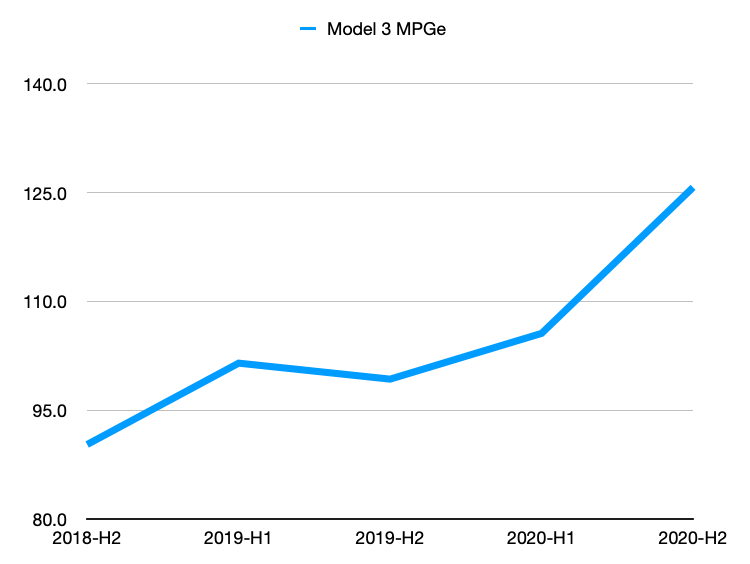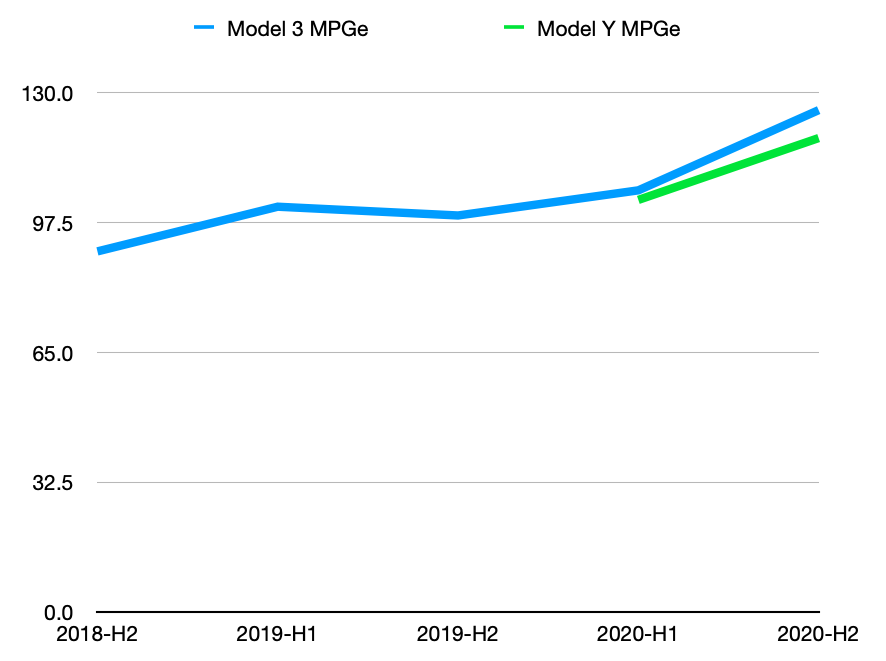Doubts may still linger about the potential of battery electric vehicles for mainstream transportation, but EVs are getting progressively better. And if the data from the Tesla Model 3 and Model Y fleet is any indication, it appears that these improvements could result, at least to some degree, in an all-electric crossover being more efficient than the early production versions of an all-electric sedan.
In a recent conversation with Teslarati, David Hodge, the founder and CEO of Embark — a transportation app company that was sold to Apple in 2013 — explained that his work on a little passion project has shown something incredibly interesting about the Model 3 and Model Y’s efficiency. Hodge is currently working on the Nikola app, a service that he hopes will eventually grow to be the CarFax for EVs. So far, users of the app have driven about 7,000,000 miles, and over 2,000 Model 3s are registered in the fleet.
These Model 3s are comprised of vehicles that were produced from the beginning of Elon Musk’s first “alien dreadnought” attempt to cars that rolled off the line this quarter. Based on data that the Nikola app proprietor shared, it is evident that the Model 3 has gotten significantly more efficient over the years. Users of the app with vehicles produced in 2018, for example, showed a real-world average MPGe of 90.3, while cars that were produced in 2019 had a real-world average of 100.4.

These efficiency improvements continued in the first half of 2020, when Nikola app users who owned Model 3s showed a real-world average MPGe of 105.2. Interestingly enough, Tesla appears to have rolled out a major improvement to the Model 3’s efficiency in the second half of the year, as vehicles produced after June 2020 have shown a real-world average MPGe of 125.7. That’s the biggest improvement in the Model 3’s efficiency yet, at least as reflected in data from the Nikola app’s users.
Inasmuch as the improvements in the Model 3’s MPGe are notable, the efficiency of the Model Y appears to be even more noteworthy. The Model Y is the newest vehicle in Tesla’s lineup today, having started deliveries earlier this year. But even with its early ramp, it is becoming quite evident that Tesla did something special with the all-electric crossover.
Nikola app users who owned Model Ys that were produced in the first half of 2020 showed a real-world average MPGe of 103.2, which was very close to the MPGe of Model 3s that were manufactured in the same period. And just like the Model 3s, Model Ys that were produced after June 2020 exhibited a significant improvement in efficiency, with the vehicles having a real-world average MPGe of 118.7. That’s higher than the MPGe of Model 3s that were produced just last year.

As noted by Hodge, such efficiency figures from the Model Y are extremely impressive, especially considering that it is larger and significantly heftier than the Model 3. This is also a pretty unique situation considering that the company’s flagship sedan, the Model S, has always been significantly more efficient than its SUV counterpart, the Model X.
“This is pretty impressive considering the obvious aerodynamic differences in the Y and the fact that the S has always outperformed the X by about 15. If you just look at cars made since June, the Model Y MPGe climbed to 119 on average, but it looks like some of the tech improvements made it over to the 3, which is seeing 125.6 MPGe average in that period,” Hodge noted.
Tesla has a habit of rolling out improvements to its vehicles as soon as they are available. The latest Teslas are therefore expected to have the best tech that the company has to offer at the time of their production. With this in mind, and as per the findings of auto teardown expert Sandy Munro, the Model Y is indeed equipped with Tesla’s best, both in tech and in design. And considering that the all-electric crossover is expected to share components with its sedan sibling, it is not very surprising to see the Model 3 experience efficiency gains as soon as the Model Y started ramping up. Such is simply the nature of Tesla.

News
Tesla Model 3 named New Zealand’s best passenger car of 2025
Tesla flipped the switch on Full Self-Driving (Supervised) in September, turning every Model 3 and Model Y into New Zealand’s most advanced production car overnight.

The refreshed Tesla Model 3 has won the DRIVEN Car Guide AA Insurance NZ Car of the Year 2025 award in the Passenger Car category, beating all traditional and electric rivals.
Judges praised the all-electric sedan’s driving dynamics, value-packed EV tech, and the game-changing addition of Full Self-Driving (Supervised) that went live in New Zealand this September.
Why the Model 3 clinched the crown
DRIVEN admitted they were late to the “Highland” party because the updated sedan arrived in New Zealand as a 2024 model, just before the new Model Y stole the headlines. Yet two things forced a re-evaluation this year.
First, experiencing the new Model Y reminded testers how many big upgrades originated in the Model 3, such as the smoother ride, quieter cabin, ventilated seats, rear touchscreen, and stalk-less minimalist interior. Second, and far more importantly, Tesla flipped the switch on Full Self-Driving (Supervised) in September, turning every Model 3 and Model Y into New Zealand’s most advanced production car overnight.
FSD changes everything for Kiwi buyers
The publication called the entry-level rear-wheel-drive version “good to drive and represents a lot of EV technology for the money,” but highlighted that FSD elevates it into another league. “Make no mistake, despite the ‘Supervised’ bit in the name that requires you to remain ready to take control, it’s autonomous and very capable in some surprisingly tricky scenarios,” the review stated.
At NZ$11,400, FSD is far from cheap, but Tesla also offers FSD (Supervised) on a $159 monthly subscription, making the tech accessible without the full upfront investment. That’s a game-changer, as it allows users to access the company’s most advanced system without forking over a huge amount of money.
News
Tesla starts rolling out FSD V14.2.1 to AI4 vehicles including Cybertruck
FSD V14.2.1 was released just about a week after the initial FSD V14.2 update was rolled out.

It appears that the Tesla AI team burned the midnight oil, allowing them to release FSD V14.2.1 on Thanksgiving. The update has been reported by Tesla owners with AI4 vehicles, as well as Cybertruck owners.
For the Tesla AI team, at least, it appears that work really does not stop.
FSD V14.2.1
Initial posts about FSD V14.2.1 were shared by Tesla owners on social media platform X. As per the Tesla owners, V14.2.1 appears to be a point update that’s designed to polish the features and capacities that have been available in FSD V14. A look at the release notes for FSD V14.2.1, however, shows that an extra line has been added.
“Camera visibility can lead to increased attention monitoring sensitivity.”
Whether this could lead to more drivers being alerted to pay attention to the roads more remains to be seen. This would likely become evident as soon as the first batch of videos from Tesla owners who received V14.21 start sharing their first drive impressions of the update. Despite the update being released on Thanksgiving, it would not be surprising if first impressions videos of FSD V14.2.1 are shared today, just the same.
Rapid FSD releases
What is rather interesting and impressive is the fact that FSD V14.2.1 was released just about a week after the initial FSD V14.2 update was rolled out. This bodes well for Tesla’s FSD users, especially since CEO Elon Musk has stated in the past that the V14.2 series will be for “widespread use.”
FSD V14 has so far received numerous positive reviews from Tesla owners, with numerous drivers noting that the system now drives better than most human drivers because it is cautious, confident, and considerate at the same time. The only question now, really, is if the V14.2 series does make it to the company’s wide FSD fleet, which is still populated by numerous HW3 vehicles.
News
Waymo rider data hints that Tesla’s Cybercab strategy might be the smartest, after all
These observations all but validate Tesla’s controversial two-seat Cybercab strategy, which has caught a lot of criticism since it was unveiled last year.

Toyota Connected Europe designer Karim Dia Toubajie has highlighted a particular trend that became evident in Waymo’s Q3 2025 occupancy stats. As it turned out, 90% of the trips taken by the driverless taxis carried two or fewer passengers.
These observations all but validate Tesla’s controversial two-seat Cybercab strategy, which has caught a lot of criticism since it was unveiled last year.
Toyota designer observes a trend
Karim Dia Toubajie, Lead Product Designer (Sustainable Mobility) at Toyota Connected Europe, analyzed Waymo’s latest California Public Utilities Commission filings and posted the results on LinkedIn this week.
“90% of robotaxi trips have 2 or less passengers, so why are we using 5-seater vehicles?” Toubajie asked. He continued: “90% of trips have 2 or less people, 75% of trips have 1 or less people.” He accompanied his comments with a graphic showing Waymo’s occupancy rates, which showed 71% of trips having one passenger, 15% of trips having two passengers, 6% of trips having three passengers, 5% of trips having zero passengers, and only 3% of trips having four passengers.
The data excludes operational trips like depot runs or charging, though Toubajie pointed out that most of the time, Waymo’s massive self-driving taxis are really just transporting 1 or 2 people, at times even no passengers at all. “This means that most of the time, the vehicle being used significantly outweighs the needs of the trip,” the Toyota designer wrote in his post.
Cybercab suddenly looks perfectly sized
Toubajie gave a nod to Tesla’s approach. “The Tesla Cybercab announced in 2024, is a 2-seater robotaxi with a 50kWh battery but I still believe this is on the larger side of what’s required for most trips,” he wrote.
With Waymo’s own numbers now proving 90% of demand fits two seats or fewer, the wheel-less, lidar-free Cybercab now looks like the smartest play in the room. The Cybercab is designed to be easy to produce, with CEO Elon Musk commenting that its product line would resemble a consumer electronics factory more than an automotive plant. This means that the Cybercab could saturate the roads quickly once it is deployed.
While the Cybercab will likely take the lion’s share of Tesla’s ride-hailing passengers, the Model 3 sedan and Model Y crossover would be perfect for the remaining 9% of riders who require larger vehicles. This should be easy to implement for Tesla, as the Model Y and Model 3 are both mass-market vehicles.











